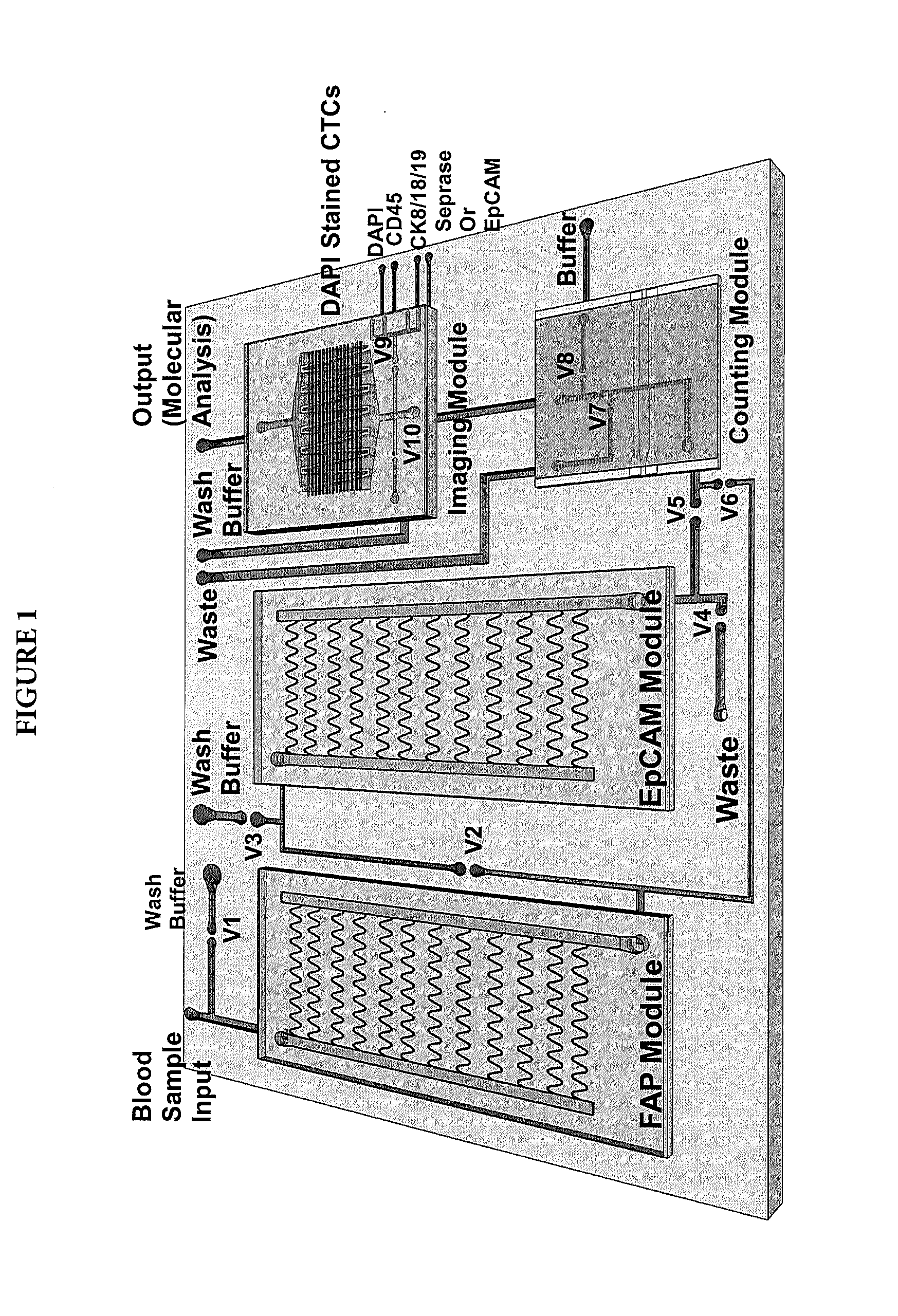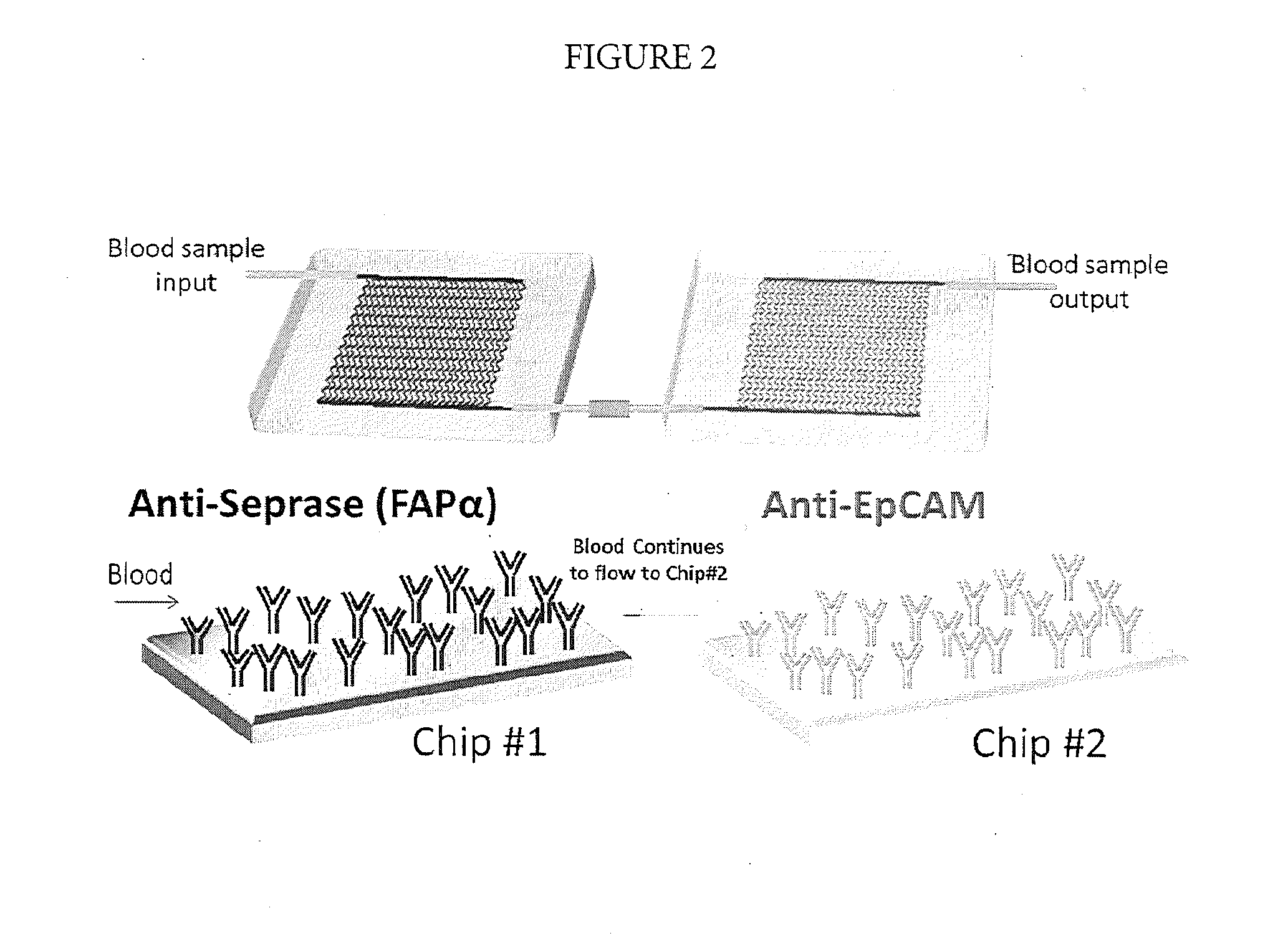Vitro capture and analysis of circulating tumor cells
a technology of tumor cells and in vitro capture, applied in the field of cancer biology, can solve the problems of not capturing cells with low or no, poor sensitivity and specificity of metastatic cases, and a large number of cancer deaths
- Summary
- Abstract
- Description
- Claims
- Application Information
AI Technical Summary
Benefits of technology
Problems solved by technology
Method used
Image
Examples
example 1
[0054]Selection of Seprase(+) and EpCAM(+) Circulating Tumor Cells (CTCs) from the Peripheral Blood of Pancreatic Cancer Patients
[0055]The following clinical measurements were secured from an approved IRB (University of North Carolina, Chapel Hill, Lineberger Cancer Center). These measurements are intended to illustrate embodiments of the present invention and not intended to limit the scope of the invention. The current invention is intended to include all adenocarcinomas or solid tumors.
Materials & Methods
[0056]The CTC microchips used for selection of seprase and EpCAM positive cells were fabricated in a thermoplastic (cyclic olefin co-polymer, COC or poly(methylmethacrylate), PMMA). The CTC microchips consisted of an architecture comprised of 50 sinusoidally-shaped channels that emanated from a common input and converged into a common output (see Adams et al., Highly Efficient Circulating Tumor Cell Isolation form Whole Blood and Label-Free Enumeration Using Polymer-based Microfl...
example 2
Determining the Ratio of Seprase(+) and EpCAM(+) CTCs from the Peripheral Blood of Patients with Various Cancers
[0066]CTC microfluidic chips were fabricated in COC substrates. The chip design consisted of a 26.3×20.5 mm footprint with inlet and outlet leading channels (20.5 mm long, 400 μm wide, and 150 μm deep) connecting a series of 50-curvilinear channels that in concert formed the cell selection bed. FIG. 1 shows the CTC selection chip design. Each curvilinear selection channel was 30.6 mm long, 150 μm deep, and 25 μm wide. The surface area of the CTC selection bed was 596 mm2 (11 mm2 / channel) with 45.1 mm2 of that surface area in the lead channels. The chip's total volume was 9.4 μL (138 nL / channel) with 2.5 μL volume for the lead channels.
[0067]The depth of these channels increased the throughput as well as provided reduced pressure drop throughout the selection channels, especially when occupied by captured CTCs. On average, the widths of microchannels are only slightly large...
example 3
Expression Analysis of CTCs Captured with Seprase-Targeting Affinity Reagent
[0075]Using the methods described herein, CTCs were captured, released, enumerated via impedance detection (no staining performed), and collected in a microtube. The collected CTCs were spun spin down and lysed using ˜20 μL of lysing solution from a commercially available Cell-to-CT™ kit (Life Technologies, Grand Island, N.Y.). Cells-to-CT™ technology enables reverse transcription of lysates from 10-105 cells without isolating or purifying RNA. Eliminating the RNA isolation step substantially expedites and simplifies gene expression analysis of cells. As an alternative, CTCs lysis and isolation of RNA was performed directly using the CTC capture bed. This can be performed when another set of serially connected chips, modified with FAPα and EpCAM, is used to enumerate cells and characterize their phenotype via immunostaining.
[0076]Samples after lysis were treated with DNase to remove residual gDNA from the to...
PUM
 Login to View More
Login to View More Abstract
Description
Claims
Application Information
 Login to View More
Login to View More - R&D
- Intellectual Property
- Life Sciences
- Materials
- Tech Scout
- Unparalleled Data Quality
- Higher Quality Content
- 60% Fewer Hallucinations
Browse by: Latest US Patents, China's latest patents, Technical Efficacy Thesaurus, Application Domain, Technology Topic, Popular Technical Reports.
© 2025 PatSnap. All rights reserved.Legal|Privacy policy|Modern Slavery Act Transparency Statement|Sitemap|About US| Contact US: help@patsnap.com


